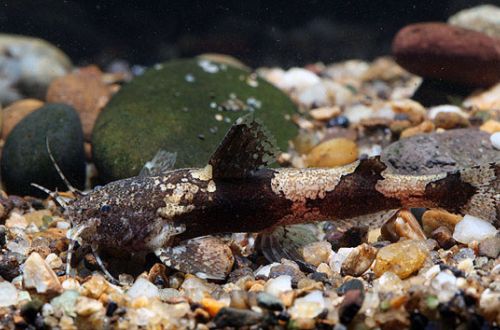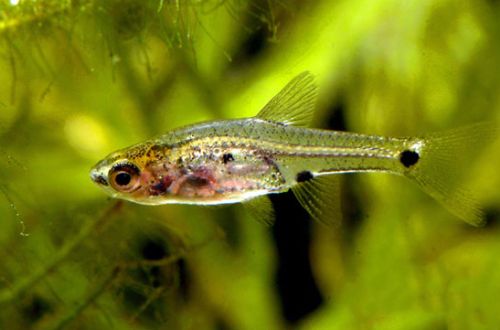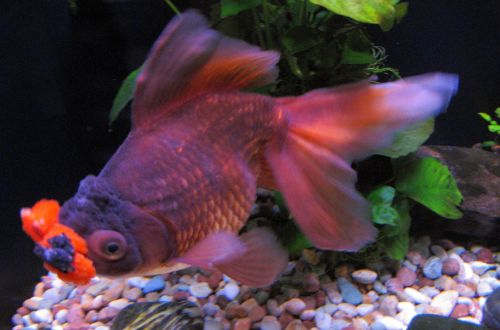
Aksis Hendrickson
Akisis Hendrickson, scientific name Akysis hendricksoni, belongs to the family Akysidae (Akizovye). This inconspicuous catfish is one of the few representatives of the family contained in aquariums. It is predominantly nocturnal and tends to hide during the day. Such secrecy predetermined its not too high popularity in the aquarium trade.

Contents
Habitat
It comes from Southeast Asia from the peninsular part of Malaysia and the southern provinces of Thailand. The typical habitat is fast-flowing streams and rivers with gravel and sand substrates. The turbidity of water is determined by the change of dry and wet seasons. Aquatic vegetation is usually not characteristic, sometimes present on flooded snags in the form of mosses and ferns.
Brief information:
- The volume of the aquarium – from 40 liters.
- Temperature – 16-24°C
- Value pH — 6.0–7.2
- Water hardness – 2–12 dGH
- Substrate type – sand, gravel
- Lighting – any
- Brackish water – no
- Water movement – moderate or strong
- The size of the fish is 4–5 cm.
- Food – live or frozen food
- Temperament – peaceful
- Content alone or in a group
Description
Adults reach a length of 4–5 cm. The color palette combines yellow and brown shades. The body pattern can vary considerably among fish caught in different rivers, but the front part will always be dark. The first rays of the dorsal and pectoral fins turned into sharp spikes designed to protect the fish from small predators. Sexual dimorphism is weakly expressed, there are no obvious visible differences between male and female.
Food
The basis of food should be small invertebrates, for example, live or frozen bloodworms, brine shrimp, daphnia. Dry flakes and pellets may also be accepted over time, but should only be considered as a supplement to the main diet.
The catfish is nocturnal, so food should be served before the lights are turned off.
Maintenance and care, arrangement of the aquarium
The optimal size of the aquarium for a pair of catfish starts from 40 liters. Sandy soil and several large stones and boulders are used in the design. It is noted that these fish like to hide in crevices during the daytime, so several such shelters can be provided. Otherwise, they themselves will find suitable places for themselves, sometimes not the best, for example, between the internal equipment and the walls of the aquarium, etc.
For landscaping, if necessary, artificial or live plants are placed. As the latter, it is desirable to use unpretentious varieties, for example, Anubias, Bucephalandra, as well as various mosses and ferns.
Keeping Hendrickson’s Akisis is quite simple, provided a few simple requirements are met: clean water, rich in dissolved oxygen, and a moderate current. To do this, they carry out regular maintenance of the aquarium and install the necessary equipment, the most important of which is the filtration and aeration system.
Behavior and Compatibility
Peaceful calm catfish, unable to compete with other more active bottom fish, especially if they are too large. They can live alone or in a group. Safe for freshwater shrimp. As neighbors, species that live in the water column or near the surface are suitable, from among Danio, Rasbor, small Tetrs.
Breeding / breeding
At the time of writing, there is a paucity of available information on successful breeding of catfish in home aquaria. It is likely that these problems will arise for the following reasons. Firstly, it is difficult to determine the sex of the fish, so you will need to purchase a fairly large batch to guarantee the presence of at least one male / female. Secondly, the stimulus for spawning is a change in the external environment associated with the arrival of the rainy season, respectively, in the aquarium it will be necessary to recreate similar conditions – changes in temperature and hydrochemical composition of water.
Fish diseases
The cause of most diseases is unsuitable conditions of detention. A stable habitat will be the key to successful keeping. In the event of symptoms of the disease, first of all, the quality of the water should be checked and, if deviations are found, measures should be taken to correct the situation. If symptoms persist or even worsen, medical treatment will be required. Read more about symptoms and treatments in the Aquarium Fish Diseases section.





